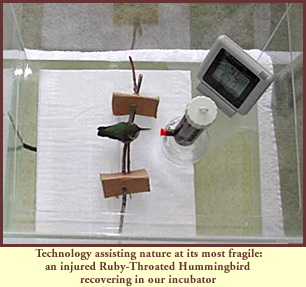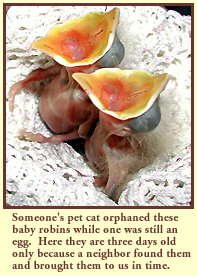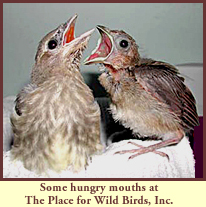|
FREQUENTLY
ASKED QUESTIONS:
Q: What do wildlife rehabilitators do?
 A: Wildlife rehabilitators
provide direct, hands-on care for wild animals in distress, allowing
them to regain their health and return to the wild. The Place
for Wild Birds, Inc., rehabilitates birds with problems such
as broken bones, wounds, and avian diseases. Some birds that
are brought to us are orphaned and need to be hand-raised. A: Wildlife rehabilitators
provide direct, hands-on care for wild animals in distress, allowing
them to regain their health and return to the wild. The Place
for Wild Birds, Inc., rehabilitates birds with problems such
as broken bones, wounds, and avian diseases. Some birds that
are brought to us are orphaned and need to be hand-raised.
The Place for Wild Birds, Inc., cares for
the physical needs of its patients, meeting their specific medical,
nutritional, and housing requirements. Each bird has an individual
medical and feeding program tailored to meet the needs of its
particular species, age, and state of health. In order to provide
the finest care possible, we work closely with local veterinarians,
attend wildlife seminars, read the latest scientific journals,
and network with other rehabilitators and wildlife clinics.
We must also consider the psychological aspects
of rehabilitating wildlife in order to minimize the stress caused
by captivity while preparing each animal for a successful existence
in the wild. It is necessary for us to be familiar with the natural
history of each species, including its characteristic habitat,
feeding mannerisms, migration activity, and breeding behavior.
 Our goal is to do what is best for the individual
bird, and its species as a whole. We know that the animal in
our care is wild, and the primary objective of our therapy is
to return this wild animal to its natural environment, strengthening
its native population. Our goal is to do what is best for the individual
bird, and its species as a whole. We know that the animal in
our care is wild, and the primary objective of our therapy is
to return this wild animal to its natural environment, strengthening
its native population.
Bird rehabilitation is hard work, but we are
rewarded at release time when a bird that we have helped finally
flies free again!

Q: What can I do to help wildlife before
they are injured?
 A:
Birds that come to us for rehabilitation have a variety of
problems and, unfortunately, too many of them are caused by contact
with humans and their pets. One of the most important things
that you can do to help songbirds is to keep cats indoors. Cats are imported pets (not native
wildlife) and are directly responsible for a great decline in
our songbird population. It is estimated that at least 3 billion
American birds are killed by cats each year! We at The Place
for Wild Birds adore cats and have many beloved felines ourselves,
but we keep them indoors knowing that they will live longer and
healthier lives -- and that they will leave the wildlife alone. A:
Birds that come to us for rehabilitation have a variety of
problems and, unfortunately, too many of them are caused by contact
with humans and their pets. One of the most important things
that you can do to help songbirds is to keep cats indoors. Cats are imported pets (not native
wildlife) and are directly responsible for a great decline in
our songbird population. It is estimated that at least 3 billion
American birds are killed by cats each year! We at The Place
for Wild Birds adore cats and have many beloved felines ourselves,
but we keep them indoors knowing that they will live longer and
healthier lives -- and that they will leave the wildlife alone.
Another way to help birds is to think of the
effects your actions may have on the environment. Remember that
when you use poison to control insects, mice and rats, you may
be harming the birds that regularly eat these pests as part of
their natural diet.
Don't leave dangerous solutions or products
around like antifreeze, car oil, cooking oil, styrofoam chips,
or lawn and garden chemicals. Many toxic substances that we carelessly
use and throw away may look like food to wildlife, and can be
deadly when ingested.
Cut apart the plastic rings on six-pack holders,
and never dispose of used fishing line without first cutting
the line into small pieces.
You can help prevent birds from flying into
windows by decorating the glass with decals or sun-catchers.
And before cutting down trees or bushes in
the spring and summer, check them for nests. By postponing such
activities until fall, you may help a pair of birds fledge their
young!

Q: What if I find an injured bird?
A: If you find
an injured, sick, or orphaned bird, put it in a box in a dark,
quiet place far away from children and pets. Do not handle the
bird except to secure its safety. Do not give food or water until you have received instructions from a Wildlife Rehabilitator. Liquids can drown a debilitated
or baby bird. Feeding a bird the wrong food (including milk or
other dairy products) can also kill it.
Call a Wildlife
Rehabilitator right away for instructions. Some birds can
be safely put back where they were found, but many birds are
already in trouble by the time you pick them up. (And please
note: children should not handle wildlife. If you are a child
who has found a bird in trouble, please get a grown-up to help
you.)
Don't wait to call! Most baby birds must be
fed special diets every 15 minutes from dawn until
dusk! And the sooner we get a bird, the better chance it has.
In cases where babies can be placed back in
the wild and you have touched them, their parents will not hurt
or abandon them because of "human scent." Unlike mammals,
songbirds have virtually no sense of smell, and are extremely
good parents to their young. But always check with a rehabilitator
before doing anything. There are many other important factors
that influence whether a bird can be put back where it was found.
You should not try to raise orphaned wild
animals yourself, and please don't bring injured wildlife to
places such as pet stores or zoos! For many reasons, the public
may not legally keep wildlife. Our wildlife is best handled by
rehabilitators and wildlife clinics; that is their specialty
and what they are licensed to do.
The names of rehabilitators and wildlife clinics
can be obtained from your state's Division of Fisheries and Wildlife,
the U.S. Fish and Wildlife Service, the Environmental Police,
the Dept. of Environmental Management, the Audubon Society, and
many local veterinarians and veterinary hospitals. Please check
our Contact page for
some suggestions.

Q: What happens
when I bring a bird to you?
 A:
When you bring a bird to us, it will
be identified, examined, and given the appropriate individual
treatment. Each bird has its own record on file that also includes
your name and address, and you may call for an update on the
bird's condition. A:
When you bring a bird to us, it will
be identified, examined, and given the appropriate individual
treatment. Each bird has its own record on file that also includes
your name and address, and you may call for an update on the
bird's condition.
Very sick or young birds are placed in incubators
or warm indoor cages. Older and recovering birds that need exercise
go outside into large flight cages, with minimal human contact
before release.
Each bird's injury or disease is properly
managed, and the correct diet is fed to each bird. When surgery
and X-rays are needed, local veterinarians often donate these
services.
In order to monitor their success in the wild,
some birds are banded before they are released.

Q: What does it cost to rehabilitate birds?
A: Every bird
that is rehabilitated by The Place for Wild Birds, Inc., will
stay an average of 3-4 weeks in our care at a minimum cost to
us of $75.00 per bird. Rehabilitators are not paid by the state
or federal government and rely solely on donations to help pay
for the food, medicine, and caging that are vital for the successful
rehabilitation of wildlife.
Each year it costs more for us to care for
wild birds. At the same time, as we lose a greater number of
our valuable bird species forever, rehabilitation becomes an
increasingly meaningful and necessary human endeavor.
In order to continue our importaint work rehabilitating
wild birds, we need your financial support. If you would like
to join in our effort to help the wild birds of our region, please
click here for more
information.

Q: Why should we help wild birds?
A: Modern life
can be busy, and we humans are often caught up in our jobs and
daily family activities. Living in our houses and driving in
our cars, it is easy to become separated from nature and forget
how important it is to our very existence. But it is a fact that
the human race has evolved and still lives in an ecosystem that
includes all living and non-living things. We are part of a "biotic
community," dependent on the living things around us for
our survival. Wild birds are an example of living things that
we affect, and that have an effect on us.
Besides being remarkable, interesting, beautiful
creatures that are full of life, adding layers of color, sound
and motion to our gardens and wilderness areas, our wild birds
are sensitive barometers of the health of the environment. What
we do to ourselves, we also do to them, but the effects are often
visible far sooner and far more profoundly in wild bird populations.
Some birds are farmers, in a way. Nectar sippers
help pollinate many of our prized flowering plants, both wild
and cultivated. Seed eaters help to spread seeds of wild plants.
And carrion-eaters help natural decomposition, which feeds the
earth and enriches the soil.
Birds also function as natural pest control,
serving as means of "constant suppression," our quiet
(and sometimes not so quiet!) partners working behind the scenes
to control insects and vermin. Raptors such as hawks and owls
are nature's mousetraps. Aerial insectivores such as swallows
and swifts help control bugs which can carry disease or devour
plants.
Man's increasing presence on earth does not
always have a positive impact on the wild birds around us. Some
species are already extinct; others are declining rapidly and
soon may also disappear. Low-profile, non-exotic (to us), and
receiving very little publicity, our native species of wild birds
are valuable in ways that are not always obvious, or even measurable,
until they are gone.
If we are to survive as a species, humans
will need to stay aware of the natural world that surrounds us.
Man has evolved in the company of wild birds, and by helping
them to survive, we are also helping ourselves to survive.

Many other questions about birds and wildlife
often go unasked because we think we already know the answers.
Would you like to find out how much you really know? If so, visit
our Myths & Misconceptions
section.
 [Home]
[Whoooo are we?] [the
Story of Baby Birds] [Myths & Misconceptions]
[Home]
[Whoooo are we?] [the
Story of Baby Birds] [Myths & Misconceptions]
[FAQs] [How
you can help] [Photo Gallery] [Contact] [Donations]
[Shopping]
[Emergency? Click
here.]
This website and all its contents
belong to The Place for Wild Birds, Inc.
Copyright © 2002, all rights reserved. Reproduce only with
permission.
All photographs by Walter S. Bezaniuk. Most illustrations by
Kathleen Frisbie.
Site design and some illustrations by Sara. |